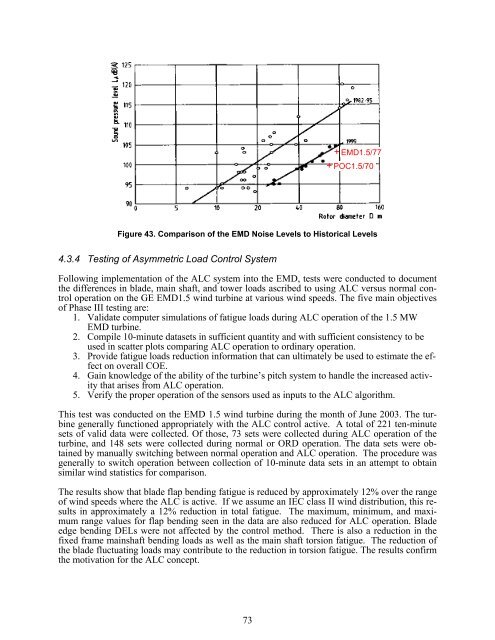Advanced Wind Turbine Program Next Generation Turbine ... - NREL
Advanced Wind Turbine Program Next Generation Turbine ... - NREL
Advanced Wind Turbine Program Next Generation Turbine ... - NREL
You also want an ePaper? Increase the reach of your titles
YUMPU automatically turns print PDFs into web optimized ePapers that Google loves.
+ EMD1.5/77<br />
+ POC1.5/70<br />
Figure 43. Comparison of the EMD Noise Levels to Historical Levels<br />
4.3.4 Testing of Asymmetric Load Control System<br />
Following implementation of the ALC system into the EMD, tests were conducted to document<br />
the differences in blade, main shaft, and tower loads ascribed to using ALC versus normal control<br />
operation on the GE EMD1.5 wind turbine at various wind speeds. The five main objectives<br />
of Phase III testing are:<br />
1. Validate computer simulations of fatigue loads during ALC operation of the 1.5 MW<br />
EMD turbine.<br />
2. Compile 10-minute datasets in sufficient quantity and with sufficient consistency to be<br />
used in scatter plots comparing ALC operation to ordinary operation.<br />
3. Provide fatigue loads reduction information that can ultimately be used to estimate the effect<br />
on overall COE.<br />
4. Gain knowledge of the ability of the turbine’s pitch system to handle the increased activity<br />
that arises from ALC operation.<br />
5. Verify the proper operation of the sensors used as inputs to the ALC algorithm.<br />
This test was conducted on the EMD 1.5 wind turbine during the month of June 2003. The turbine<br />
generally functioned appropriately with the ALC control active. A total of 221 ten-minute<br />
sets of valid data were collected. Of those, 73 sets were collected during ALC operation of the<br />
turbine, and 148 sets were collected during normal or ORD operation. The data sets were obtained<br />
by manually switching between normal operation and ALC operation. The procedure was<br />
generally to switch operation between collection of 10-minute data sets in an attempt to obtain<br />
similar wind statistics for comparison.<br />
The results show that blade flap bending fatigue is reduced by approximately 12% over the range<br />
of wind speeds where the ALC is active. If we assume an IEC class II wind distribution, this results<br />
in approximately a 12% reduction in total fatigue. The maximum, minimum, and maximum<br />
range values for flap bending seen in the data are also reduced for ALC operation. Blade<br />
edge bending DELs were not affected by the control method. There is also a reduction in the<br />
fixed frame mainshaft bending loads as well as the main shaft torsion fatigue. The reduction of<br />
the blade fluctuating loads may contribute to the reduction in torsion fatigue. The results confirm<br />
the motivation for the ALC concept.<br />
73
















